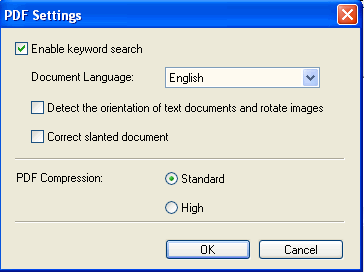Scan using MP Navigator - MP140 (Windows)
| Article ID: ART120795 | | | Date published: 05/12/2015 | | | Date last updated: 08/17/2015 |
Description
Solution
Scanning using MP Navigator
MP Navigator enables you to scan documents such as photographs and magazines
1. On the Windows desktop, double-click ![]() MP Navigator 3.1.
MP Navigator 3.1.
Alternatively, on the Windows taskbar, click 'Start', and point to (All) Programs, Canon Utilities, then MP Navigator 3.1. Then click 'MP Navigator 3.1'.
MP Navigator opens.
2. Point to Scan/Import and click 'Photos/Documents (Platen)'.
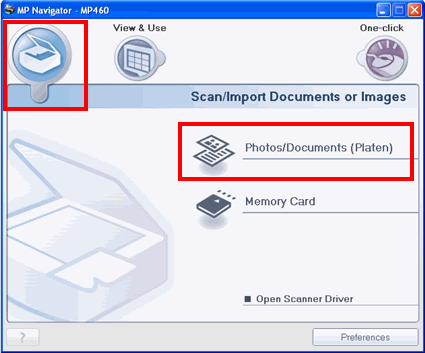
3. Place the document face-down on the platen glass, and select 'Document Type'.
How to place the document and Document Type depends on the document to be scanned.
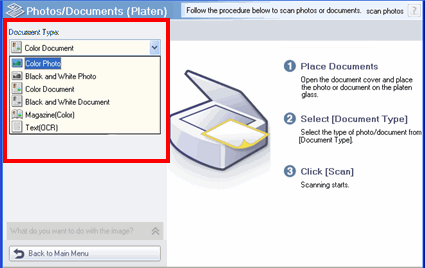
How to place the document
Allow 3/8 inches (1 cm) or more space between the edges of the platen glass and the document.
Align a corner of the document with the corner at the arrow of the platen.
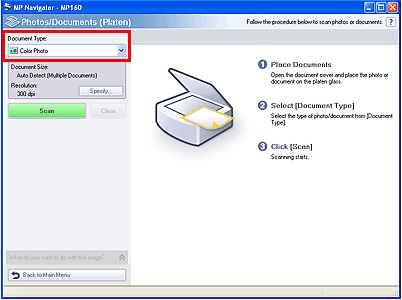
- When you select Color Photo or Black and White Photo, the position or size of the image may not be scanned correctly if you do not leave 3/8 inches (1 cm) or more space between the edges of the platen glass and the document.
- When you select Color Photo or Black and White Photo, the position or size of the image may not be scanned correctly depending on the document. In such a case, select Document Size such as A4 or Letter according to the document to be scanned.
- When you select Magazine(Color), the Descreen function will be enabled and scanning takes longer than usual. To reset the Descreen function, disable Descreen in the Scan Settings dialog box.
4. Click 'Specify'... and set the preferences as required.
The Scan Settings Dialog Box opens. Specify the Document Size and Scanning Resolution.
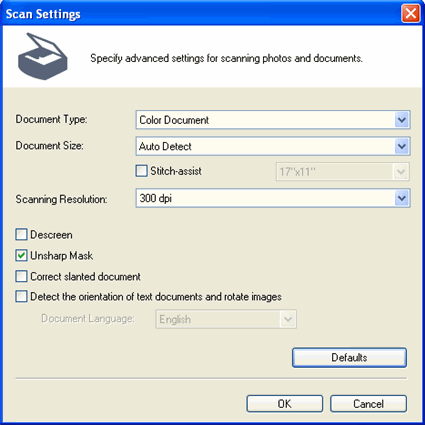
- When Document Size is Auto Detect or Auto Detect(Multiple Documents), the position or size of the image may not be scanned correctly depending on the document. In such a case, select Document Size, such as A4 or Letter according to the document to be scanned.
5. Click 'Scan'.
Scanning will begin.
When the document has been scanned, the scanned image is displayed in the Thumbnail List area.
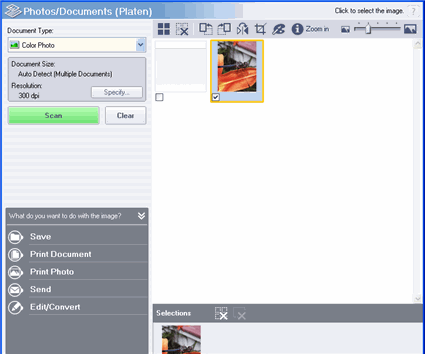
6. Edit the scanned image as required.
When there are multiple images, first select images to edit. (An orange frame appears around the selected image.)
Note: You can drag the mouse or use Shift + arrow keys to select multiple images. (An orange frame appears around the selected image.)
7. Select what to do with the scanned image data.
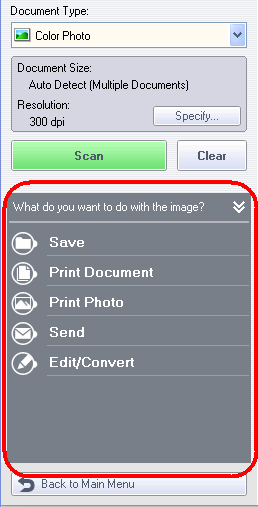
Save to PC , Save as a PDF file , Print Document , Print Photo , Send via E-mail , Edit
Saving
MP Navigator allows you to save the scanned image data in a specified folder.
1. Scan the images into MP Navigator, then select them.
2. Click 'Save', then click 'Save to PC' on the list.
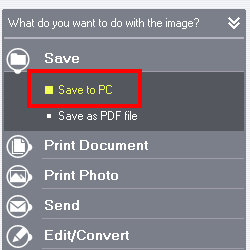
3. Specify the following settings as required:
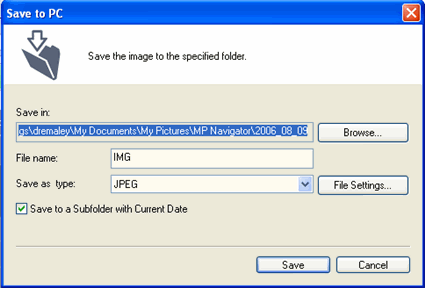
Save in:
Display the destination folder in which to save the scanned image. To change the destination, click 'Browse'... and specify another folder. The MP Navigator folder in the My Pictures (Windows 98: My Documents) folder is specified by default.
File name:
Enter the file name of the image to be saved (up to 32 characters). When saving multiple files, 4 digits are appended to each file name.
Save as type:
Select a file type to save the scanned image. JPEG, TIFF, and BMP are available.
Note: You cannot select JPEG when Document Type is Text(OCR). For JPEG images, you can click 'File Settings'... to select a compression type in the resulting dialog box from High(Low Compression), Standard, and Low(High Compression).
Save to a Subfolder with Current Date:
Select whether to create a subfolder, in which to save the scanned image, with the current date (for example, "2006_01_01" which indicates "Year_Month_Date").
4. Click 'Save'. The scanned image will be saved as specified.
Saving as a PDF File
1. Scan the images into MP Navigator, then select them.
2. Click 'Save', then click 'Save as a PDF file' on the list.
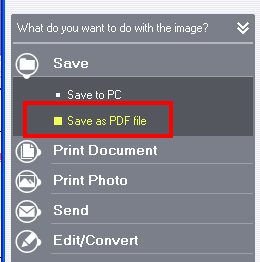
Note: You cannot select Save as PDF file when a PDF file is included in the selected image files.
3. Specify the following settings as required:
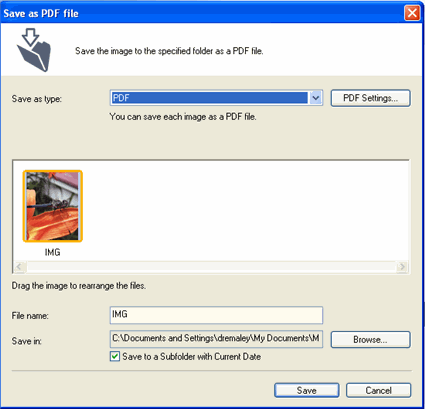
Save as type:
Select a file type to save the scanned image
PDF: When multiple images are selected, save each image as a PDF file.
PDF(Multiple Pages): Save multiple images in one PDF file.
PDF(Add Page): Add selected images to a PDF file. The selected images are added to the last page of the PDF file. You cannot rearrange pages of the PDF file to which images are added.
Note: You can add only the files created by MP Navigator.
Note: PDF(Multiple Pages) is displayed when multiple images are selected.
PDF Settings...
Configure advanced settings for creating a PDF file.
Enable keyword search:
Check this setting to convert characters in a document to text data. This will enable an easy search by keyword.
Document Language:
Select the language of the document to be scanned.
Detect the orientation of text documents and rotate images:
Detects the orientation of the document from the scanned text, and rotates the scanned image to the correct orientation.
Scanning takes longer than usual when you enable Detect the orientation of text documents and rotate images.
This function may not be available depending on the region.
This function may not work properly depending on the document language. Only text documents written in languages that can be selected from Document Language are supported
The orientation of the following types of documents may not be corrected, as the text cannot be detected correctly.
- The resolution is outside the range of 300-600 dpi.
- Font size is outside the range of 8-48 points.
- Documents containing special fonts, effects, italics, or hand-written text.
- Documents with patterned backgrounds.
Correct slanted document:
Detects the scanned text and corrects the angle (within -0.1 to -10 degrees or +0.1 to +10 degrees) of the document.
Scanning takes longer than usual when you enable Correct slanted document.
The inclination of the following types of documents may not be corrected, as the text cannot be detected correctly.
- Documents in which the text lines are inclined more than 10 degrees or the angles vary by line.
- Documents containing vertical and horizontal text.
- Documents with extremely large or small fonts.
- Documents with small amount of text.
- Documents containing figures/images or hand-written text.
- Documents containing vertical and horizontal lines (tables).
PDF Compression:
Select a compression type for saving.
The following images can be compressed with high efficiency.
- Images smaller than 10,500 pixels in the vertical direction.
- Images with resolutions of 200-600 dpi. (Example: A4 or Letter-size document scanned at 600 dpi)
Add to:
This setting is available when you select PDF(Add Page) for Files of type and specify the PDF file to which images are added. To change the destination, click 'Browse'... to specify.
You can select only PDF files created by MP Navigator. You cannot select PDF files created by other applications. PDF files edited by other application programs cannot have pages added to them even if they were originally created by MP Navigator.
File name:
Enter the file name of the image to be saved (up to 32 characters). When saving multiple files, 4 digits are appended to each file name.
Save in:
Display the destination folder. To change the destination, click 'Browse'... and specify another folder. The MP Navigator folder in the My Pictures (Windows 98: My Documents) folder is specified by default.
Save to a Subfolder with Current Date:
Select whether to create a subfolder, in which to save the scanned image, with the current date (for example, "2006_01_01" which indicates "Year_Month_Date").
4. Click 'Save'.
Printing Document
MP Navigator allows you to copy multiple scanned data at once and trim the scanned images before copying.
1. Scan the images into MP Navigator, then select them.
2. Click 'Print Document'.
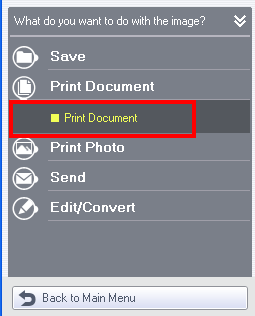
3. Specify the following settings as required:
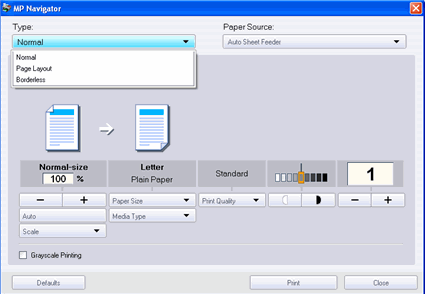
Type:
Select a print type.
Normal: Print the image on a sheet of paper
Page Layout: Layout and print multiple images on a sheet of paper. Click Layout to select how images will be allocated
Borderless: Print the image on an entire sheet of paper without a frame.
Paper Source:
Select paper feed source.
Enlarge/Reduce:
Enlarge or reduce images to print.
- +: Print reduced or enlarged image by specifying a scale in increments of 1%.
100% Normal-size: Print the image in normal size.
Scale: Select a scale from the list.
Auto: Scale is adjusted automatically according to the detected paper width and the selected paper size. Image may be printed rotated 90 degrees depending on its size.
Note: At 100% Normal-size, some images may be printed small or with some portions cropped. In this case, select 'Auto' to resize the print in proportion to the paper size.
Paper Size:
Select the size of paper on which the image is to be printed. Match the size to the size of the media set in the machine.
Media Type:
Select the media type for printing. Print quality may be fixed depending on Media Type.
Print Quality:
Select the print quality.
Density:
Click
to select the print density. This cannot be changed when you select Text (OCR) for Document Type, and then scan images.
Copies:Click - or + to select the number of copies to be printed.
Grayscale Printing:
Select this checkbox to print the document in black and white.
Defaults:
Click this to restore the factory pre-defined settings.
4. Click 'Print'.
Printing starts when the color setting is specified.
Print Scanned Photograph Images
You can easily print high-quality images using Easy-PhotoPrint. This application is suited for printing photograph images taken with a digital camera.
1. Select the image and click Print Photo, then click Print Photo on the list.
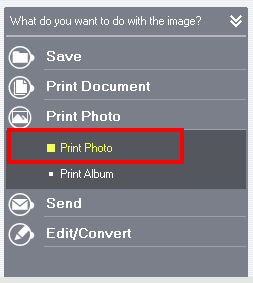
Easy-PhotoPrint starts.
Note: The Print Photo button is displayed only when Easy-PhotoPrint is installed
2. Configure the Easy-PhotoPrint settings according to preference.
Sending via E-mail
You can send a scanned image by attaching it to an e-mail.
MP Navigator is compatible with the following e-mail software programs:
- Outlook Express
- Microsoft Outlook
- EUDORA
- Netscape Messenger
(If an e-mail software program does not operate properly, check that the MAPI setting of the e-mail software program is enabled. For details, see the instruction manual of the e-mail software program for the MAPI setting.)
You cannot select images scanned at 5105 pixels or more in the horizontal direction when selecting PDF for Save as type.
1. Scan the images into MP Navigator, then select them.
2. Click 'Send', then click 'Attach to E-mail' on the list.

3. Specify the following settings as required:
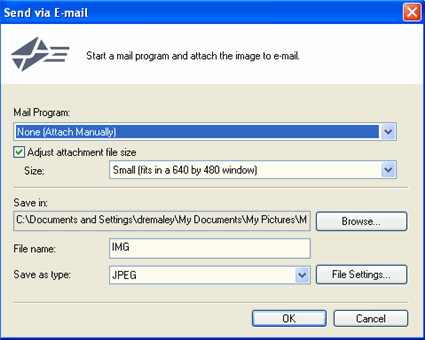
Mail Program:
The e-mail program set up on the Preference dialog box of the main menu screen will be displayed. Specify your e-mail application.
Adjust attachment file size:
When Save as type is JPEG, checking this setting allows you to change the size of the file to be attached. You can select the file size of the image to be attached with Size.
Save in:
Display the destination folder in which to save the attached image. To change the destination, click 'Browse'... and specify another folder. If the image file to be attached is resized, the resized image file is saved. By default, folders are created and named with the current date (for example, "Mail_20060101") under the MP Navigator folder in the My Pictures (Windows 98: My Documents) folder.
File name:
Enter the file name of the image to be attached (up to 32 characters). When saving multiple files, 4 digits are appended to each file name.
Save as type:
Select the file type of the image to be attached from JPEG, PDF, and PDF(Multiple Pages).
- Save as type is displayed when the image is scanned with Photos/Documents (Platen).
- PDF(Multiple Pages) is displayed when multiple images are selected.
- For JPEG images, you can click 'File Settings'... to select a compression type in the resulting dialog box from High(Low Compression), Standard, and Low(High Compression).
4. Click 'OK'.
The image file is saved in the folder specified in Save in, and the e-mail software program starts.
5. Specify the recipient, then enter the subject and the e-mail message.
See the operation manual of your e-mail software program for details of e-mail settings.
Editing Data
You can use the applications that accompany this machine to edit scanned photograph images or convert scanned documents into text. Scan/import images into MP Navigator, and select what you want to do with them.
Select the image and click 'Edit/Convert', then click 'Convert to text file' or 'Open PDF file'.
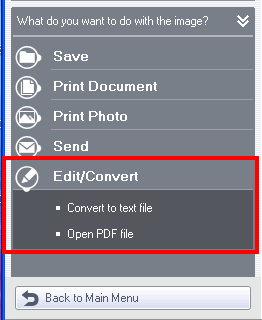
Convert Document to Text
You can convert the printed words in magazines and newspapers scanned as images to text (character) data using ScanSoft OmniPage SE. Data converted to text can be edited by word processing software.
Note : This function may not be available depending on the product and region.
1. Select the image and click 'Edit/Convert', then click 'Convert to text file' on the list. ScanSoft OmniPage SE starts.
Note : The Convert to text file button is displayed only when ScanSoft OmniPage SE is installed.
2. Convert the data to text with ScanSoft OmniPage SE. See the ScanSoft OmniPage SE manual for details on the settings available.
Edit PDF file
You can open PDF files with the configured application, and edit or print them.
1. Select a PDF file.
Note : PDF files can only be selected from the View & Use Images on your computer screen.
2. Click 'Edit/Convert', then click 'Open PDF file' on the list. The application associated with PDF files will start.
Note : The Open PDF file button is displayed only when the application associated with PDF files is installed.
3. Configure the settings using the application with which you opened the PDF file, then edit and print the files. See the operation manual of the application for details of the settings available.

